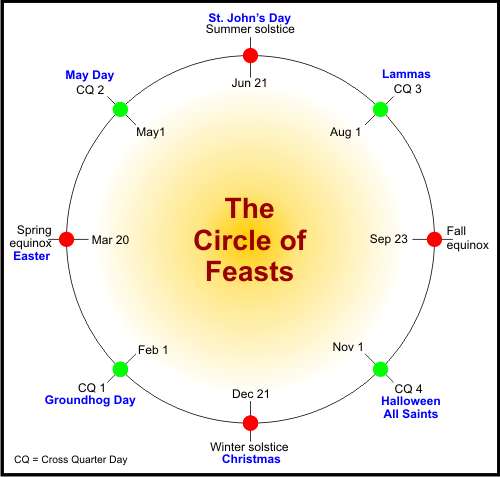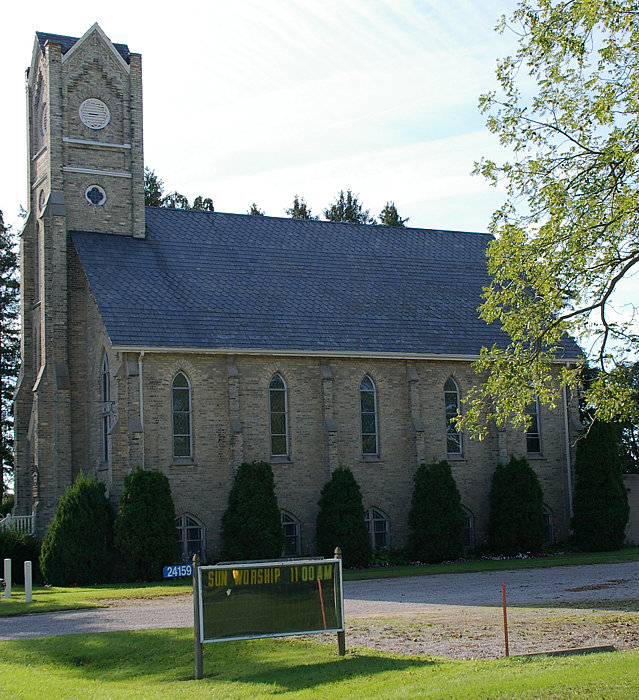
 |
Freethought & Rationalism ArchiveThe archives are read only. |
|
|
#1 |
|
Veteran Member
Join Date: Jan 2006
Location: London, Ontario, Canada
Posts: 1,719
|
In another thread it has been remarked that when it comes to the relation between e.g. the winter solstice and the date of Christmas, much opinion but little actual facts are adduced. I want to make a start in presenting some facts with the following chart, which I have specifically prepared for this august audience:
 First some explanations, then I'll state my purpose. The red circles are the "primary" points in the solar yearly cycle, most people will be familiar with them: the two solstices and the two equinoxes. The winter solstice is when the days (in terms of daylight) are the shortest, at the summer solstice they are the longest. At the two equinoxes the length of the daytime equals the nighttime, in the Spring while the daytime is increasing, in the Fall while it is decreasing. Less familiar may be the green circles. These are the so called "cross quarter days:" the days halfway between the solstices and equinoxes. With each of these points I have indicated the approximate date. Even with our very fine-tuned modern calendar, the dates can vary by a day. Which brings me to a short note on accuracy of calendars. The "natural" divisions of calendar time are the day (based on the rotation of the earth), the month (based on the rotation of the Moon around the Earth) and the year (based on the rotation of the Earth around the Sun). Unfortunately there is not a whole number of days in either the (lunar) month or the (solar) year. As a goal of calendars is, loosely speaking, to have the same "time of year" fall on the same day each year, this is a problem. I will not go into the solution to this problem here, except to state that it takes quite a bit of "fiddling." In the old days this fiddling was not done, for various reasons. Hence in these old days the dates on which the various points in the solar cycle were seen to fall were not exact, certainly not when we try to translate old dates into our modern Gregorian calendar. This should be rembered when, below, I associate a feast with a certain solar point, and that feast does not fall on the exact day that the modern calendar would indicate as appropriate. Together with each of the eight points I have indicated, in blue, feasts that are associated with those days in the English speaking world. Other parts of the world have sometimes the same, sometimes different feasts on those days. My list of feasts is not necessarily complete, usually I mention only one feast per solar event. What should be immediately noticeable is that all points, with the exception of the Fall equinox, have a feast associated with them. And what is more, with the exception perhaps of Lammas, these are all well-known feasts. If you think that perhaps St. John's day is not so well known, then you should visit Quebec, Canada, one year on June 24 when it is St. Jean Baptiste day: all Quebec is out feasting! As you can tell, the two major Christian feasts of Christmas and Easter fall on the Winter solstice and the Spring equinox respectively. They are surrounded by the Cross Quarter feasts of Halloween, Groundhog Day and May Day, although the latter is perhaps more current in Europe than in North America (visit e.g. Bavaria during that time, and you see maypoles on every village square). My purpose in presenting this graph is then the following. Although we live in, as Sam Harris would have it, a "Christian nation," our major feasts are as a matter of simple observation closely connected to the dates of the yearly solar cycle. And that includes the two major Christian festivities. This is something that needs to be explained. I will not try and do that here, my purpose is just to show that there is something that can likely not be explained from a purely Christian point of view (although perhaps it can, at this point I don't know). And since this includes Christmas and Easter, there is some obvious, I would say, relevance for BC&H here. Please note that I am not saying that Christianity is "just some warmed-over Sun worship." What I am saying is that there are some obvious influences from the solar cycle that should not be ignored. Let me finish with a slightly lighthearted note, that nevertheless merits some contemplation. Christianity is not just Sun worship...  ... or is it  . Very funny, you might say, an innocent (visual) pun? Well, maybe. But not only do the two major Christian feasts fall on important days in the solar cycle, the major day of worship falls on a day named after the Sun. At this point all I want to say is that this reinforces that there is a link between Christian ritual and the solar cycle that merits some attention. What is needed now is to see if we can come up with some explanations, plus some cultural history regarding these days in pre-Christian times. . Very funny, you might say, an innocent (visual) pun? Well, maybe. But not only do the two major Christian feasts fall on important days in the solar cycle, the major day of worship falls on a day named after the Sun. At this point all I want to say is that this reinforces that there is a link between Christian ritual and the solar cycle that merits some attention. What is needed now is to see if we can come up with some explanations, plus some cultural history regarding these days in pre-Christian times.Gerard Stafleu |
|
|
|
|
#2 |
|
Regular Member
Join Date: Jul 2004
Location: Texas
Posts: 430
|
I lost interest when you couldn't think of a common feast for the fall equinox.
I like the pic though 
|
|
|
|
|
#3 |
|
Contributor
Join Date: Mar 2006
Location: Falls Creek, Oz.
Posts: 11,192
|
Cool stuff Gerard!
Some comments: 1) Constantine started "Sunday" in 321 CE. 2) The diagram is for the northern hemisphere: it is difficult to construct a generic solutionm to cater for both hemispheres of the planet on a concurrent basis. However seeing that: a) most people live in the north, and b) the bible may not apply to the southern hemisphere (St Augustine?) so there's no real problems. It looks like a medicine wheel of the people. |
|
|
|
|
#4 |
|
Regular Member
Join Date: Jul 2004
Location: Texas
Posts: 430
|
I'm not discounting the general premise, but the festivals seem cherry-picked to make the relationship. I've never heard of a feast for Groundhog Day. And Lammas? I have to look that one up.
But you know, If you could sell people on metric measurements across the board, why not move the whole world to a standard with 8 "metric" holidays per year. Make them always start on a Thursday, too. In fact, us Yanks have already perfected this technique of four-day-feast with Thanksgiving. I could see this happening 7 more times a year, and a full 5-day once every 4 years 
|
|
|
|
|
#5 |
|
Veteran Member
Join Date: Jan 2006
Location: London, Ontario, Canada
Posts: 1,719
|
|
|
|
|
|
#6 | |||
|
Veteran Member
Join Date: Jan 2006
Location: London, Ontario, Canada
Posts: 1,719
|
I could see that in say the Romance languages, but in Germanic? This Wikipage relates the names of the German weekdays all the way back to Babylonia:
Quote:
Quote:
In Norwegian, a language rather far removed from Constantine, we seem to have the same situation: Code:
Sunday søndag Monday mandag Tuesday tirsdag Wednesday onsdag Thursday torsdag Friday fredag Saturday lørdag Quote:
Gerard Stafleu |
|||
|
|
|
|
#7 |
|
Regular Member
Join Date: Jul 2004
Location: Texas
Posts: 430
|
|
|
|
|
|
#8 | |
|
Regular Member
Join Date: Jul 2004
Location: Texas
Posts: 430
|
Quote:

|
|
|
|
|
|
#9 | ||||
|
Veteran Member
Join Date: Jan 2006
Location: London, Ontario, Canada
Posts: 1,719
|
Quote:
Quote:
Quote:
Quote:
 ! !Gerard Stafleu |
||||
|
|
|
|
#10 |
|
Regular Member
Join Date: Jul 2004
Location: Texas
Posts: 430
|
Well I looked up Lammas, looks like you picked a good one. I guess agriculture around here is a little different, we harvest the wheat in the winter and spring usually.
But while digging around, I found the following candidates for the fall equinox: The Fall Equinox is also known as: Alban Elfed, Autumn Equinox, Autumnal Equinox, Cornucopia, Feast of Avilon, Festival of Dionysus, Harvest Home, Harvest Tide, Mabon, Night of the Hunter, Second Harvest Festival, Wine Harvest, Witch's Thanksgiving, and the first day of autumn |
|
|
| Thread Tools | Search this Thread |
|